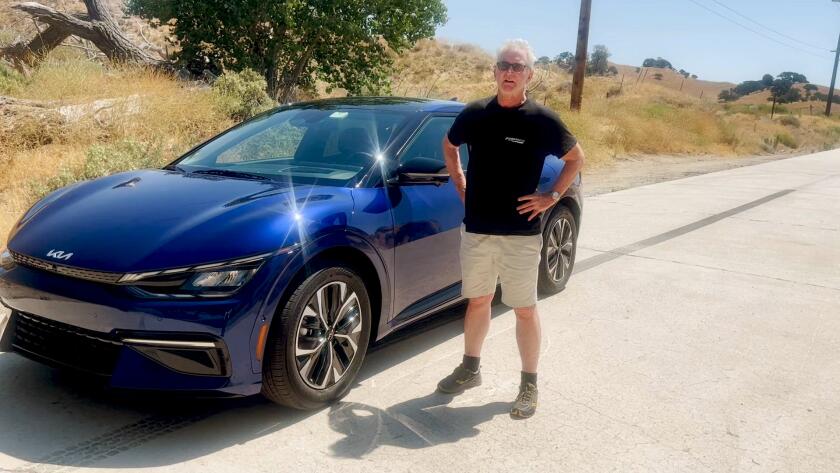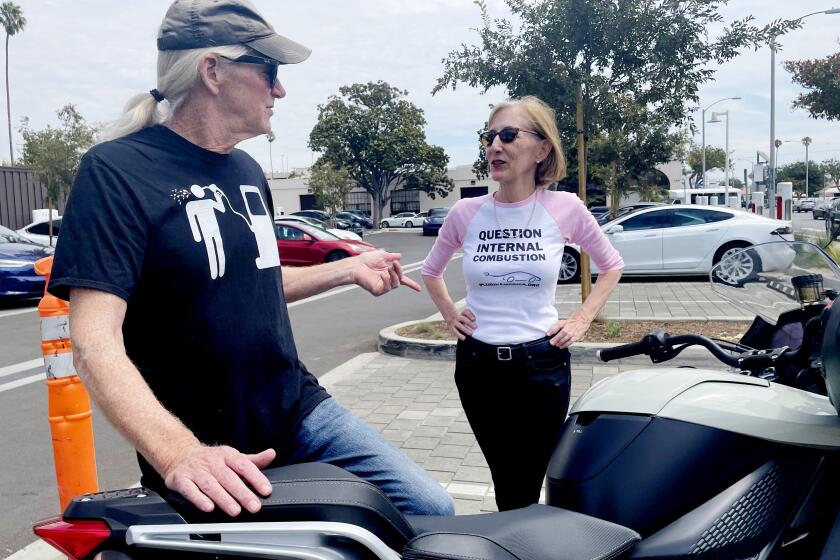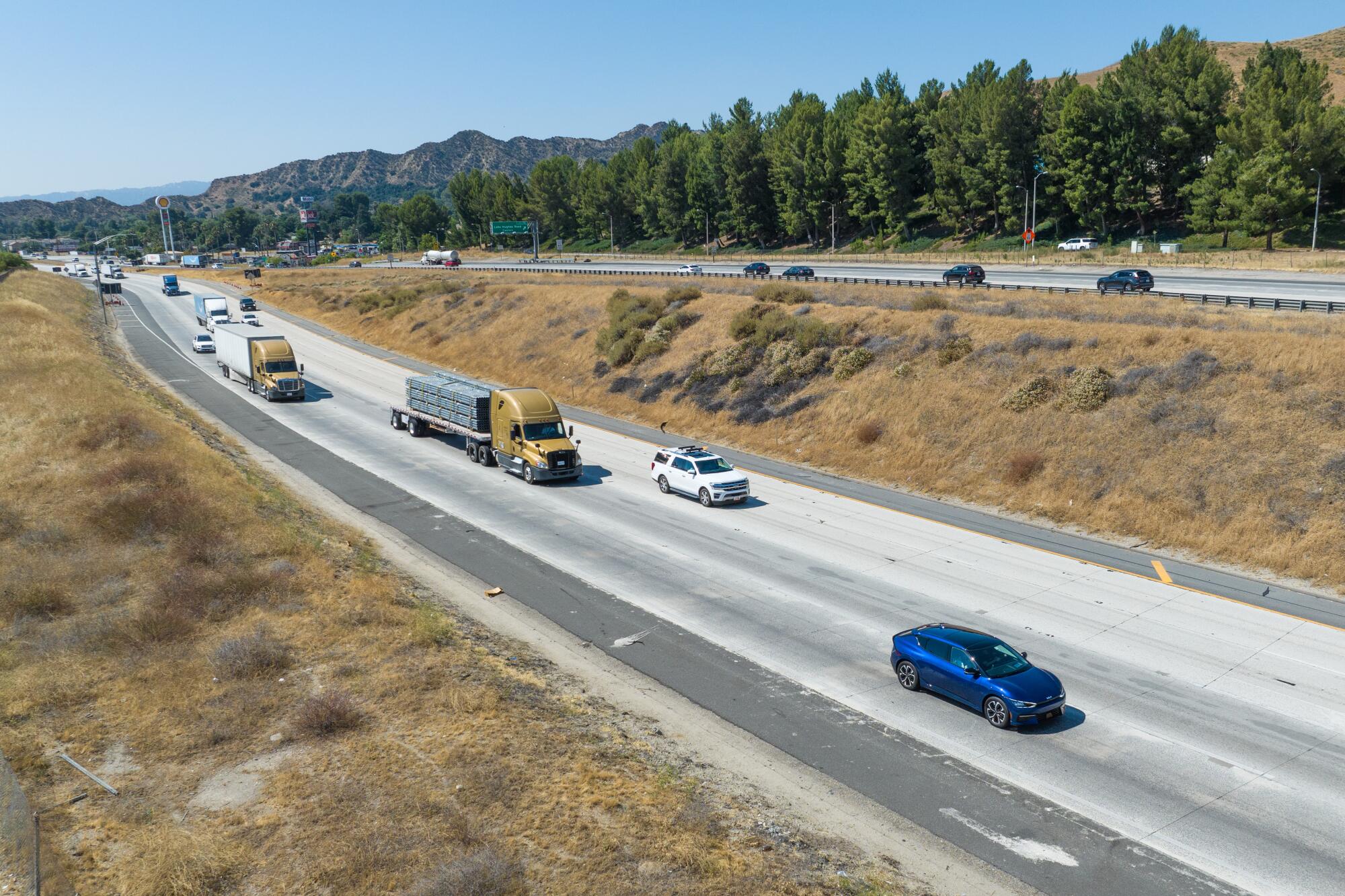
- Share via
Should you buy an electric car? If so, what kind? Pure electric? Plug-in hybrid? New? Used?
As autos writer for The Times, I’m often asked for advice on electric car buying — most recently on a drive on Interstate 5 from Los Angeles to Berkeley, where I live. I was charging up a new blue Kia EV6 outside the Harris Ranch restaurant when a woman with a young child approached.
What car is that, she wanted to know. She said she was thinking about a new EV. Should she buy one?
After telling her what I did for a living, I came back with a question as my standard response: “Why do you want to buy an electric car?” She answered the way almost everyone does: “To help the environment.”



“If doing your part to save the Earth is really your top priority,” I told her, “you should keep driving the gasoline car you already own until it’s ready for the junkyard. Then you should buy an electric car.”
Here’s the reason: If your gasoline car is in decent running condition, you’re going to sell it or trade it in. The person who buys it will keep on driving it — spewing all its pollution and greenhouse gases into the atmosphere.
In the meantime, the processes to mine the materials for and manufacture batteries produce electric motors, sheet metal, tires and other car parts, and assemble them into your new EV, also will churn out climate-harming emissions.
And, although the energy mix is changing fast, you’ll need to charge your EV with electricity that, even in California, with all its wind and solar, will be partly sourced from fossil fuels for many years to come.
Most people, I’ve found, don’t like to hear that. When they ask their questions, it’s clear what they really want is a modern new car.
If the Golden State is going to lead the world toward a better, safer future, our political and business leaders — and the rest of us — will have to work harder to rewrite the California narrative. Here’s how we can push the state forward.
Don’t get me wrong, I think electric cars are great. I’ve test-driven dozens of them. My family owns one — a 2018 BMW i3, with 120-mile range. We use it as our second car, for trips around town. We love it.
So, let’s say saving the Earth isn’t your absolute top priority, but you do want to make a contribution, however small, and you really do want to buy an electric car. But you have some worries — like unreliable public charging, range shortfalls, availability, sticker price.
Here’s my advice.
If it’s your only car
If you’re in a single-car household and plan to keep it that way, you’ll want an EV with long range.


EVs are available with top ranges from about 100 miles to more than 500. The stated range of the Kia EV6 I drove from L.A. to the Bay Area is 240 miles. I was able to get to Harris Ranch, outside Coalinga, and charge up for the rest of the trip with miles to spare. That range is enough for daily needs such as local shopping and commuting plus the occasional long-distance trip.
With a base price of $44,000 before incentives, the Kia EV6 is considered a mid-market car. Generally, the more range, the bigger the battery, and the higher the price of the car. More mining of toxic materials, too. (To get into the 500-plus range, you’re looking at the $140,000 version of the Lucid Air.)
One way to beat range anxiety while reducing, if not eliminating, greenhouse emissions: Buy a plug-in hybrid. Also known as a PHEV, these cars combine a combustion engine with a relatively small battery that powers an electric motor. A plug-in hybrid’s electric range is small — typically 25 to 50 miles. But with a home charger, and a not-too-distant commute, you can take the kids to school, go to work and do some shopping on the way home, all on battery power, no need for the combustion engine — yet it’s there for longer trips.
EVs to consider
'Budget' pick
Nissan Leaf
There aren’t many electric cars available in the (relatively) low-price end of the market. General Motors discontinued its Bolt EV, and although it plans to reintroduce the car with new battery technology, right now that leaves the Nissan Leaf with a base price of $30,000 before incentives. The estimated range won’t get you too far out of town — 149 miles — and the creature comforts are about as basic as you’d expect in this price range. But the Leaf was the first true mass market EV on the road when it was introduced in 2010, it’s highly dependable, comes standard with several driver assist features and is quieter than you might expect. A true bargain.
Range: 149 miles
Cargo capacity: 23.6 cubic feet
Seating: 5
Horsepower: 147
Torque: 236 pound feet
I recently test drove Mazda’s brand-new CX-90 crossover plug-in hybrid, base price $40,000, with a 26-mile battery. Car & Driver magazine gave it 9 points on a 10-point scale, and I agree, it’s a fine family car. The 26 miles were plenty for local use, and I was able to travel between L.A. and the Bay Area with a single five-minute stop to fill up on gasoline.
Some environmentalists don’t like PHEVs because they’re not pure electric drive and people don’t always charge up, instead relying more heavily on the gas engine. They have a point. The only way to get the greenhouse-gas savings in a PHEV is by diligently keeping the battery at full charge.
If it’s your second car
If you need a second car, an EV is a no-brainer. As mentioned, my family has a 120-mile range EV that we use all the time around town. My wife has a hybrid car that we use mainly for long journeys.


The best second-car value, I tell people, is a secondhand EV. The range on older EVs tends to be fairly low, but for local use with a gas car in the garage, long range doesn’t matter.
And smaller-range used EVs are a great deal. They’re priced low partly because people think the battery might be on its last legs. But batteries are lasting far longer than anyone expected. Most manufacturers offer an eight- or 10-year warranty on an EV’s battery, or 100,000 miles. Battery failures are proving rare, even on older vehicles, although a dropoff in range may occur on out-of-warranty vehicles as the odometer ticks higher.
EVs to consider
Midrange pick
Hyundai Ioniq 5
A sister car to the Kia EV6, built on the same platform, but with starkly different designs. Reviewers at all the car mags love the Ioniq, and so do I. Other cars in the category include the Tesla Model Y, the Ford Mach E, and the Volkswagen ID.4. All deserve consideration. The all-wheel drive version of the Ioniq 5, with a range of 256 miles, is an excellent all-around car that balances jaunty acceleration, a quiet ride and driver comfort. It looks cool, too, in a retro kind of way. The streamlined Ioniq 6 is fresh on sale and landed Car & Driver’s EV of the year. Base price is $49,000 before incentives.
Range: 303 miles
Cargo capacity: 27.2 cubic feet
Seating: 5
Horsepower: 320
Torque: 446 pound feet
For example, a 2020 Chevy Bolt EV with 20,000 miles can be had for $24,000; a 2020 Nissan Leaf with 24,000 miles for $19,000. Those are basic cars, but they’re fun to drive, and there’s nothing wrong with either of them.
Another plus: Supply chain problems have put would-be EV buyers on waitlists for many models, with months-long delays. You can buy a used EV right off the lot.
My Kia is partly electric, but half measures aren’t good enough in this climate emergency.
What to know about charging
I’m not at the point where I can recommend a pure electric car for those without a home charger. That’s bad news for people who live in apartment buildings or condo complexes. That also means that socioeconomic status largely determines whether you can buy an electric car, at any price point.


The state of California is making a big effort to subsidize chargers in apartment buildings, with an emphasis on historically disadvantaged communities. But the management of charger installations, involving property owners, landlords and tenant committees, is complicated. And you can imagine the social issues involved: Who gets to use what charger, and for how long? What happens to charger hogs? Will a charger installation mean a higher rent?
While these problems are being worked out, I advise apartment dwellers to think long and hard before they decide to go EV.
Ultra-luxury pick
Porsche Taycan Turbo S
If budget is no obstacle, never mind Lucid, Mercedes, Audi, BMW or Rivian. My pick is the Porsche Taycan Turbo S — the high end of the thoroughly expensive Taycan line, this one starts at $189,000. Sure, at 323 miles as gauged by Edmunds, it falls far short of, say, Lucid’s 400 to 500 mile range. And the software was buggy and the user interface a work in progress. But what a drive!
Range: 323 miles
Cargo capacity: Irrelevant
Seating: 4, sort of
Horsepower: 750
Torque: 774 pound feet
As for public charging — it remains a mess. Charger locations can be inconvenient. It takes a long time to charge a car — depending on the vehicle and the charger, it can take from half an hour to several hours for a full charge. (Prices vary, but on this trip Electrify America was charging 48 cents per kilowatt hour. That’s much higher than what you’d pay with a home charger, but the $50 I paid for the trip was about half what I would have paid to fill up a gas tank.) Different charger brands have different apps and different ways of operating. You need to keep that all straight.
There are signs of improvement: The federal government is spending $5 billion through 2026 to subsidize about 500,000 chargers around the country. The state of California is spending nearly $3 billion of its own. Reliability standards are being drafted by the federal government and the California Energy Commission.
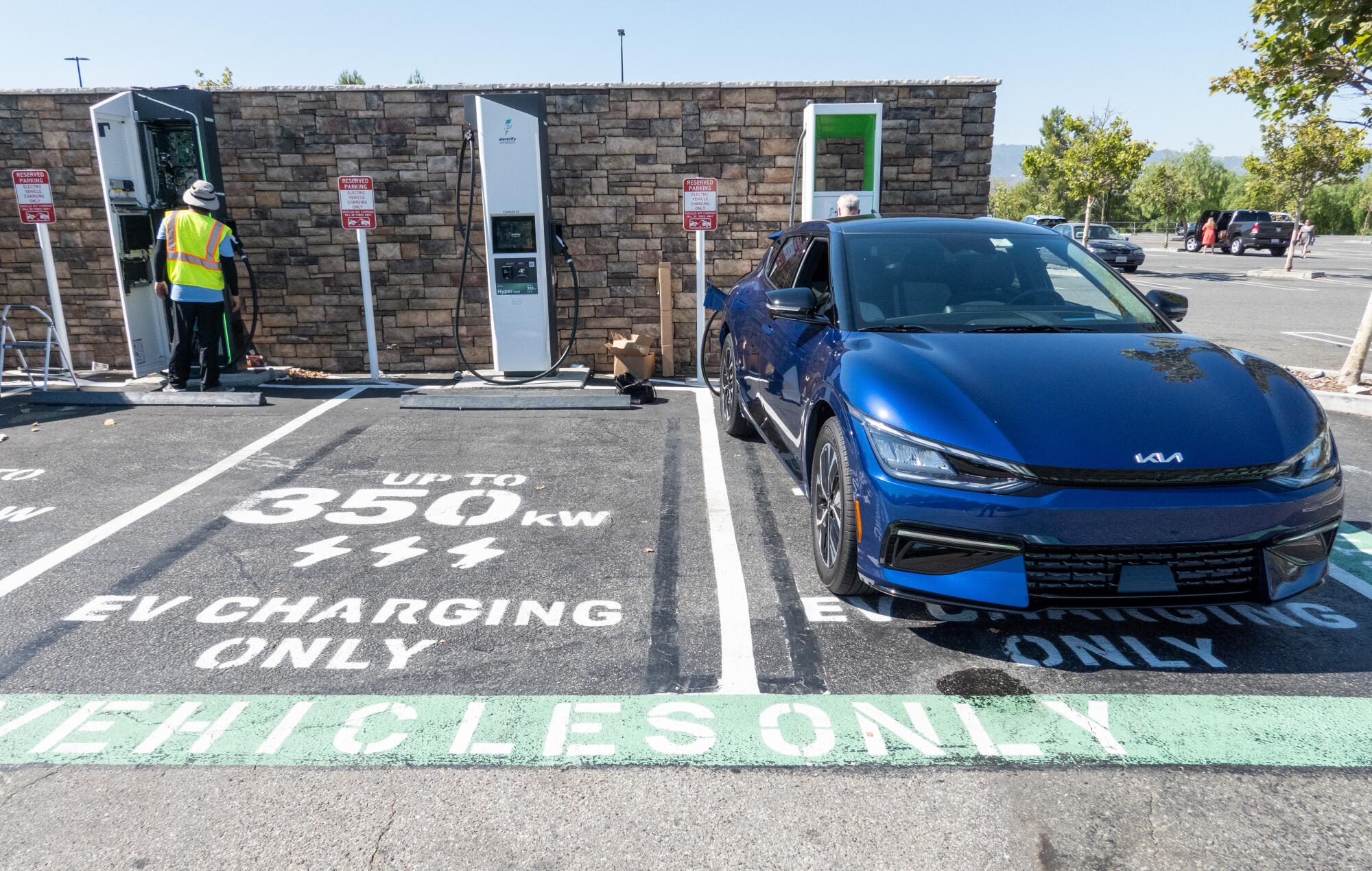
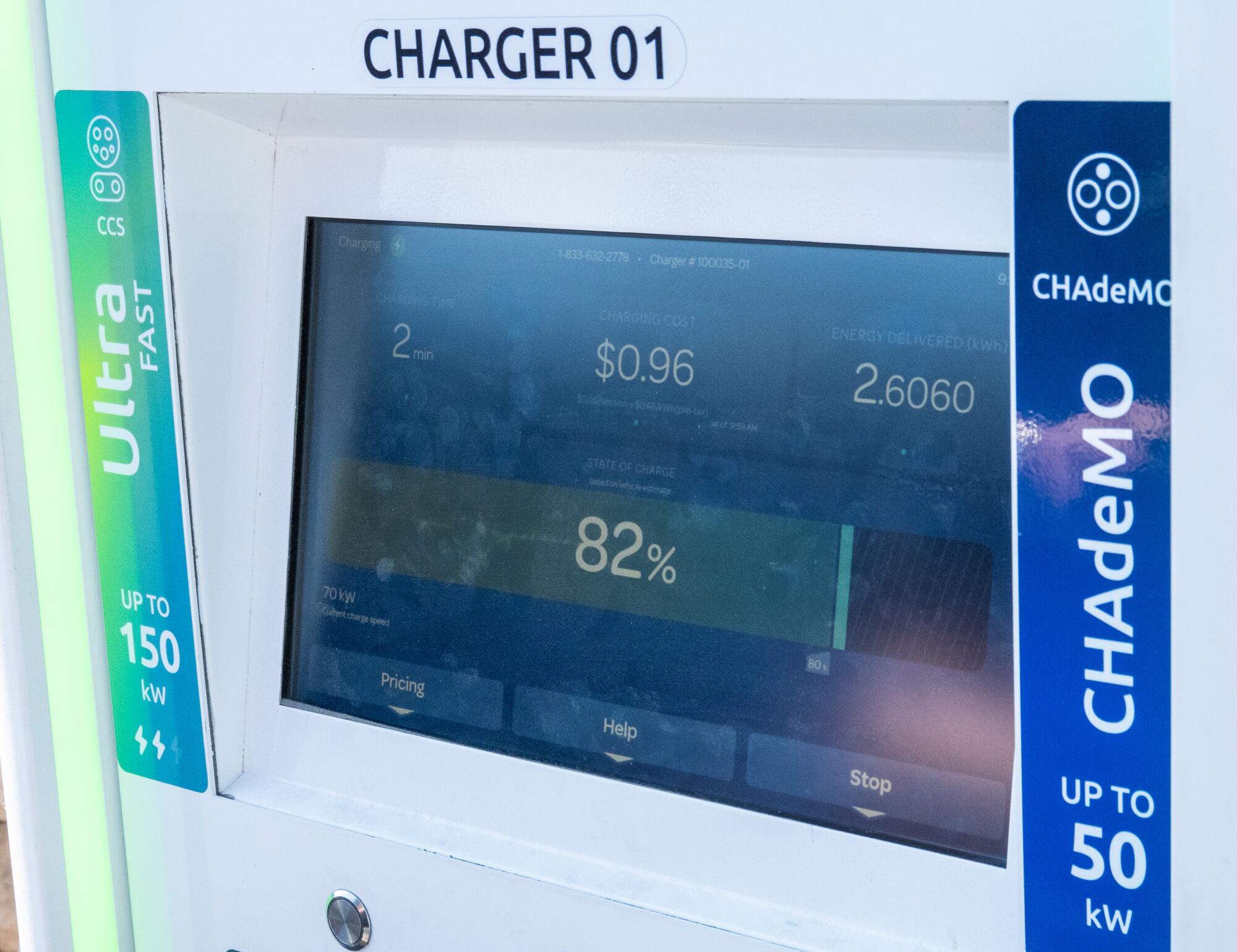
Last year, I took a trip to L.A. and back in a Ford F-150 Lightning electric pickup truck. I was impressed by the truck itself. The charging experience, not so much. It was a horror show. A trip that should take six hours took 10 on a miserable search for chargers that worked.
My recent Kia trip, I’m happy to say, was a comparative delight. I spotted maintenance workers at both Electrify America charger stations I stopped at. The chargers were working and performed without a hitch. Once that kind of trip becomes routine, more people will be interested in buying EVs.
What to know about incentives
The average price right now for an electric vehicle is more than $60,000. That’s before incentives — rebates and tax credits from state, federal and local government that can add up to a $10,000 savings per car, depending on the vehicle and in many cases, a buyer’s income.
Only 10 electric and plug-in hybrid cars will qualify for the full tax credit in the U.S. out of 90 available EV options on the market.
But the savings come at a high cost in time, energy and frustration. The tax rebates offered are so complicated, it makes shopping for a cellphone plan seem like a joy ride.
To figure out the rebate level, automakers and dealers must calculate the U.S. content of battery materials and the source of the batteries themselves. (Most are now supplied from China.) Part of any rebate depends on whether a car is manufactured in the U.S. While exceptions have been made for some overseas-assembled cars that allow rebates through leases, none currently exist for car purchases, as with the Korean-made Kia I drove up Interstate 5. If your income level is too high, or the car you want is too high-end, it might make you ineligible for a rebate.


No one has yet created a comprehensive and reliable online incentives calculator. A tool from Forbes provides a general idea of what federal money might be available, with a state and local search tool by the California Air Resources Board.
My advice on the incentive front: Get ready for some time-consuming research. And good luck.
Ask a Reporter: Inside the project
What: Times reporters Rosanna Xia and Sammy Roth will discuss “Our Climate Change Challenge” during a live streaming conversation. City Editor Maria L. LaGanga moderates.
When: Sept. 19 at 6 p.m. Pacific.
Where: This free event will be live streaming. Sign up on Eventbrite for watch links and to share your questions and comments.
More to Read
Inside the business of entertainment
The Wide Shot brings you news, analysis and insights on everything from streaming wars to production — and what it all means for the future.
You may occasionally receive promotional content from the Los Angeles Times.


